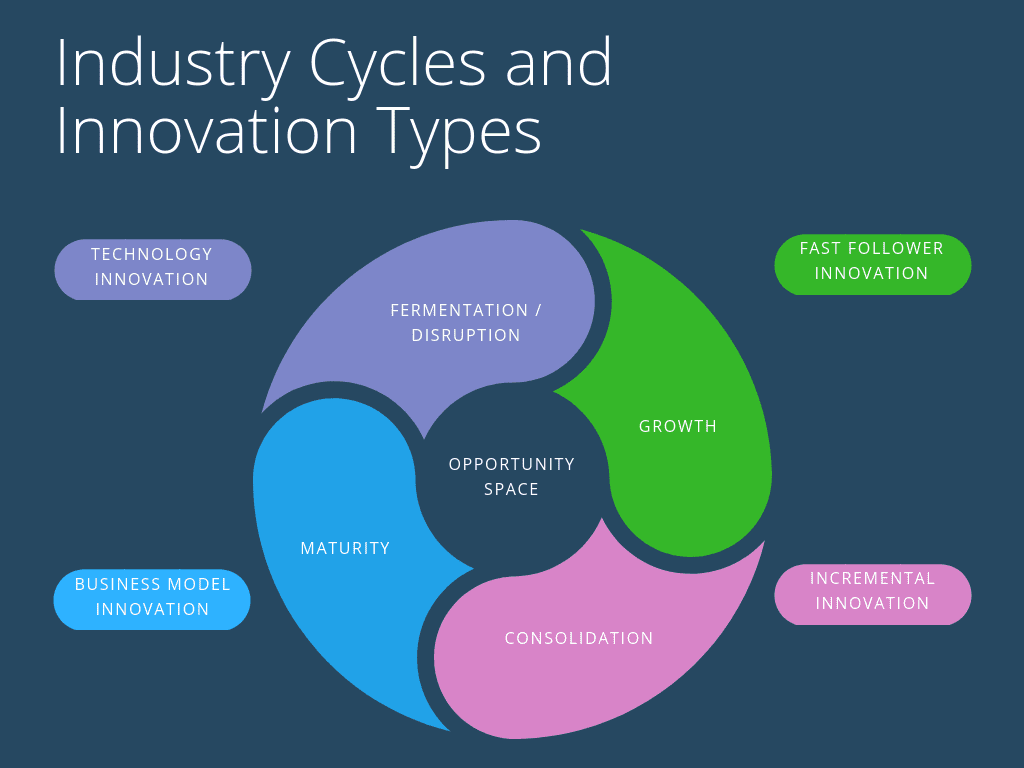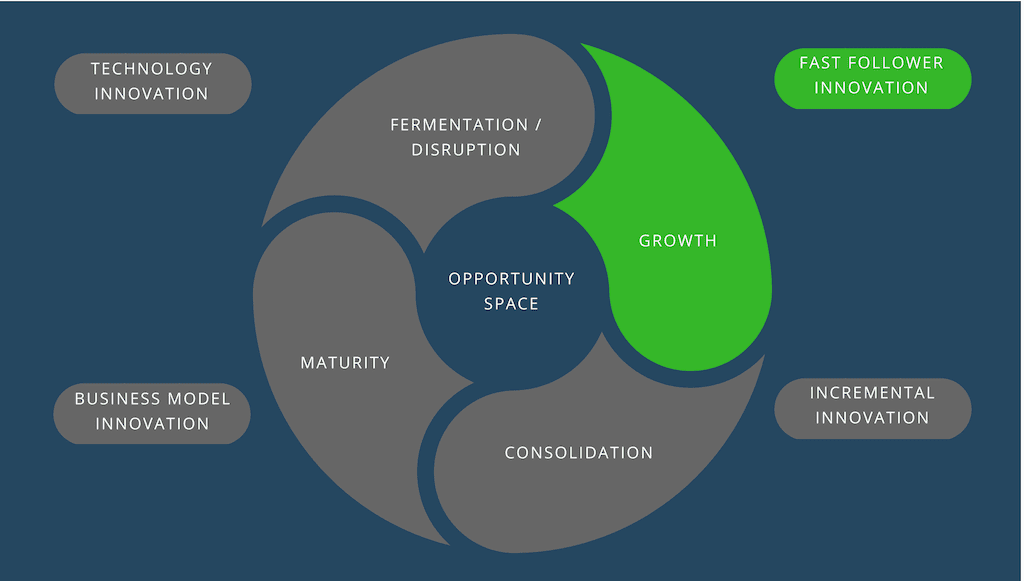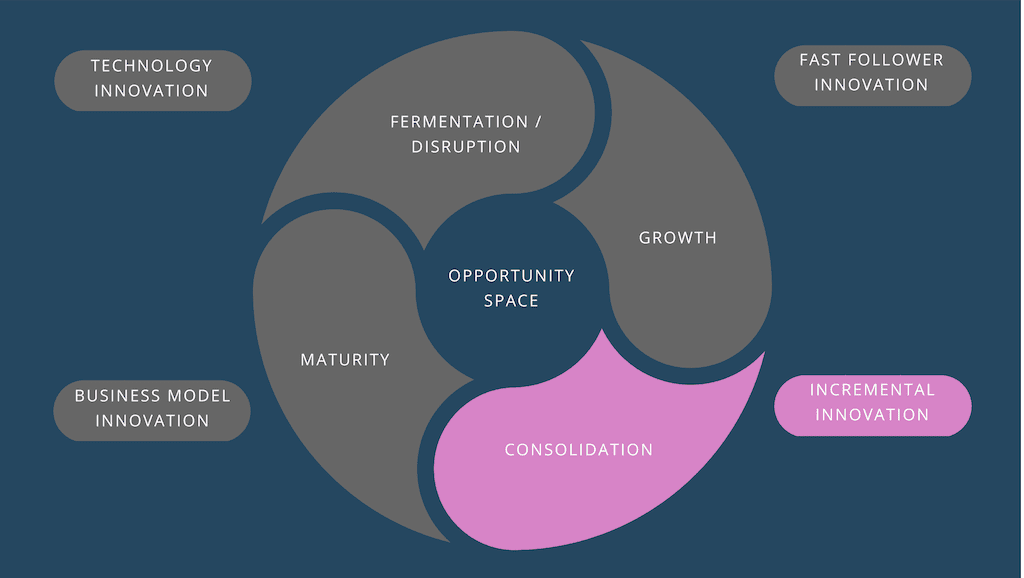Innovation is the lifeblood of an enduring business. No matter how successful your business may be today, neither the market nor the competitive landscape are standing still:
- Technology is constantly evolving
- Competitors enter the market
- Customer expectations rise
- Prices drift down and profit margins narrow

There is an innovation solution to each of these challenges. You must make sure you’re applying the right type of innovation for the challenge at hand, and find a model that allows your organisation to practice all 4 concurrently as business, product and technology cycles overlap.
Technology innovation
Successful technology innovation promises new products, new customers and long-term success. However, new technologies take a long time to develop, and then some more time to find commercial applications and become widely adopted. Some technologies may never be adopted beyond a group of niche users who benefit from its qualities and can forgive its shortcomings. Some will continue to be developed and later find a wide market of mainstream customers.
Along the way, many technologies fail to be developed beyond the prototype stage or are superseded by competing implementations or alternative solutions.
Blockchain technology has been in development for quite a few years. The core technological concepts are mature, implementations are starting to appear but a clear use case remains elusive. The same can be said about VR/AR goggles, while wireless device charging seems to be crossing the chasm towards mainstream adoption thanks to efforts by Apple and Google.
Technology innovation takes a long time – typically over 30 years, although software-only innovation such as blockchain can be quicker. It requires large capital investment, and investors are not guaranteed a return as fast followers may adopt successful new technology and add it to products and services, independently of the technology’s inventor.
Fast-follower innovation
Most of the world’s unicorns seem to fall in this category. DARPA and CERN gave us the technology that made the Internet as we know it today, but it was Google, Amazon, Uber and Airbnb who created giant successful businesses with the new technology.
While technology innovators focus on the challenge to make the technology itself, fast followers concentrate on the mass market. They may not start from an original concept: Google was not the first search engine, nor was Amazon the first online store. What they do well is taking those initial ideas and execute them brilliantly through differentiation, customer focus and scale. Timing and customer focus seems to be the key ingredient: as technology matures, fast followers will switch from making the technology incrementally more functional to using it for solving real customer problems in an intuitive way. There’s an additional feature of fast-mover innovation that makes it extremely appealing: winner-takes-all markets. As fast followers hit the sweet spot of technology maturity, product-market fit and business model scalability, the opportunity to dominate a new market for a generation becomes available.
I can’t think of an example of a large, successful business engaging in fast follower innovation successfully. This type of innovation requires full entrepreneurial commitment, a relatively short runway, skin in the game and a desire to succeed -including pivoting the entire business if the innovation scales to winner-takes-all. Large businesses struggle to commit to this kind of innovation, as payoff is neither guaranteed nor predictable, requires a kind of blind faith in success that doesn’t fit well with annual business planning, they are very attached to existing products and customers and the road to success is littered with the corpses of failed innovation.
Incremental Innovation
Every smartphone user in the world knows what incremental innovation looks like. The nature and purpose of the devices change imperceptively year after year, compelling users to upgrade their devices as new, faster, prettier models come to market. Mass-market products evolve into segmented propositions (gaming and mid-price phones have recently emerged in the Android ecosystem while a couple of years ago it was all about round edges and a choice of multiple colours).
Incremental innovation is the most common of all innovation types because it is a process that runs in harmony with customer’s increased expectations of quality, performance and design. All product and service organisations practice incremental innovation as one of their core functions, in order to remain competitive and gain -or at least retain- market share and economic value.
Business model Innovation
As industries mature and incremental innovation nears the limits of diminishing returns, organisations can explore alternative approaches to using technology to innovate, not what they provide, but how they do it. Examples of business model innovation abound: outsourcing of manufacturing and IT, digitisation of sales, service and communication channels as well as the adoption of platform/marketplace models in the supply chain are well-known examples. The goals here tend to be efficiency (driving out costs) and focus (removing activity considered non-core once reliable suppliers appear in the market).
A much more interesting variant of business model innovation exists: as organisations develop internal capability through incremental innovation, this capability acquires intrinsic value and may become a new source of business by itself. The best-known example is Amazon’s successful transition from retailer to cloud infrastructure supplier. In their quest to become better at running their own technology, Amazon created a world-class technology infrastructure capability that they were able to monetise as a separate business, launching a whole new industry in the process.
It is surprising that examples such as AWS are so infrequent. This may be a consequence of organisations’ view of their market or industry. I have encountered this in the past: this is a very powerful reason for introducing a formal owner and framework around all 4 types of innovation for most businesses.
Business model innovation presents great opportunities for organisations that can explore it beyond the narrow constraints of efficiency and scale. Many organisations have untapped opportunities in this space, and companies will do well to reflect on whether some of the efficiency measures that provide short-term financial respite may prevent them from exploring much more valuable opportunities to innovate their business model.
Time to innovate
Wherever your organisation is on your industry’s cycle, there is at least one type of innovation you should be hard at work with. Given the overlapping nature of industry, product and market cycles, you probably should be working on all 4: investing in selected new technologies, looking for adjacent categories ripe for fast follower innovation while exploring ways to pivot your business model. Innovation is complex stuff – perhaps it’s time to establish the Office of the Chief Innovator.





Good presentation for my biz plan, Tank you Roberto